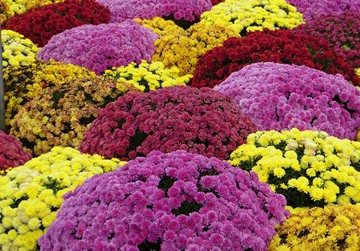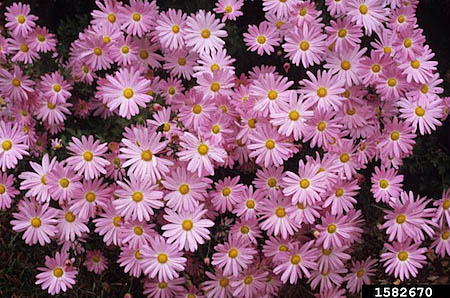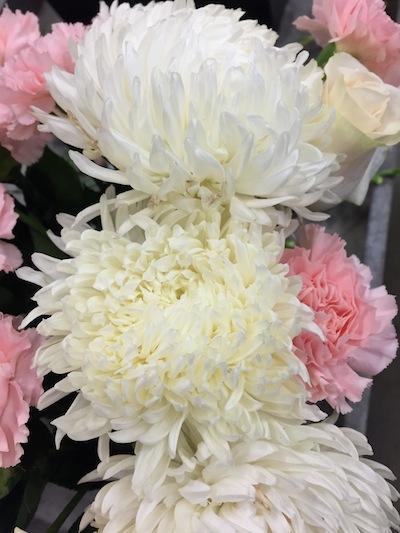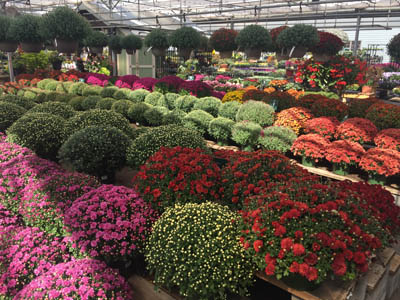Chrysanthemums — Are They Annuals or Perennials?
By Pat Dickey, Fairfax Master Gardener
 We know that fall has arrived when we see colorful Chrysanthemums at local nurseries and stores. They are a favorite flower for the fall growing season, adding that pop of color where the petunias and other annuals fade in the flower bed in front of your home or in that urn at your entryway.
We know that fall has arrived when we see colorful Chrysanthemums at local nurseries and stores. They are a favorite flower for the fall growing season, adding that pop of color where the petunias and other annuals fade in the flower bed in front of your home or in that urn at your entryway.
Chrysanthemums spp, better known as mums, were first grown in China in 15th century BC as a flowering herb for a headache remedy, and the leaves were brewed as a festive drink. Karl Linnaeus, a Swedish botanist, introduced chrysanthemums to the Western world in the 17th century, but the flowers were small, yellow and shaped like daisies, not like we see today. Flower hybridists in the US, as well as in England, France and Japan, have continued to develop countless shapes, sizes and colors of chrysanthemums since then. Mums are now available in pink, purple, red, yellow, bronze, orange and white. Their shapes now include pompom, daisy, cushion, anemone and spider, among others. Today, they are the most widely-grown potted flowers.
 Elaborate varieties of mums that you see in nurseries and at florists have been grown in a greenhouse environment and pinched continuously to produce an abundance of tiny flower buds ready to bloom for that special event or party. These potted mums are best treated as annuals. Since they have given most of their energy to producing the flower buds, their root systems are not well developed enough to adapt to cold winter temperatures. Remember to purchase mums that have not already bloomed so that they last longer in your garden.
Elaborate varieties of mums that you see in nurseries and at florists have been grown in a greenhouse environment and pinched continuously to produce an abundance of tiny flower buds ready to bloom for that special event or party. These potted mums are best treated as annuals. Since they have given most of their energy to producing the flower buds, their root systems are not well developed enough to adapt to cold winter temperatures. Remember to purchase mums that have not already bloomed so that they last longer in your garden.

Spider mums
Garden or hardy varieties of mums are also available to purchase if you want to grow them as perennials. They usually are more natural and leggy in appearance than the mounded varieties. In this area, they should be treated like tender perennials, since our unpredictably cold winters could hinder their survival until spring. The earlier they are planted in the ground, the better established they will be. They should be sited in full sun and in well-drained fertile soil. When planting garden mums, make sure the planting hole is a few inches larger than the root ball, and that the root ball is level with the ground. Then mulch them lightly and keep them watered regularly. Deadhead the flowers when they turn brown, but do not remove any of the foliage to protect the plants’ crowns for the winter ahead. You may want to add additional mulch material to your garden mums, such as straw or evergreen boughs, to protect the plants from the cold. Or, you can move them to a more protected area, such as a garage, if frigid temperatures are predicted.

football mums
When spring arrives, new growth will begin to emerge from the crowns. This is the time to cut back the old stems. Fertilize every three to four weeks with an all-purpose fertilizer. Stop fertilizing at the end of August since excessive fertilizing can weaken the plants and reduce flowering. Mums need to be pinched back throughout the summer so that the plants produce more blooms late in the season. Begin pinching when they reach 5 inches in height. Remove 1 to 2 inches (2-5 cm) of new growth every two to three weeks. Continue to pinch the plants back until mid-July. Blooms should begin to appear in three to four weeks.
Chrysanthemums are subject to Pythium root rot, bacterial blight and web blight. Consult the 2021 VCE Pest Management Guide for pesticide applications in severe cases, at Chapter 4, Control of Ornamental Diseases.
 References
References
• Chrysanthemums care (fact sheet), Merrifield Garden
Center. Thank you to the staff at Merrifield Garden
Center for their expertise and help with my questions
about mums.
• National Chrysanthemum Society, USA
• Control of Ornamental Diseases, 2021 Virginia
Cooperative Extension Pest Management Guide, p. 4-7,
Table 4.1
…updated 2021